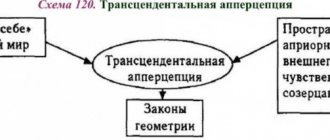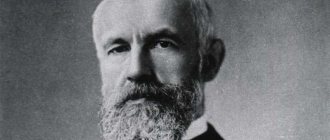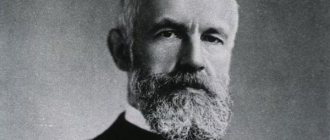Definition of consciousness.
Definition of consciousness
faces many difficulties associated with very different approaches to this problem. The problem of consciousness is one of the most global and complex problems in psychology.
Basic approaches to the problem.
"Consciousness
“,” wrote V. Wundt, “
lies only in the fact that we generally find in ourselves any mental states
. Consciousness psychologically represents, from this point of view, a kind of inner glow, which can be bright or darkened, or even fades away completely, as, for example, during deep fainting (Ledd). Therefore it can only have purely formal properties; they are expressed by the so-called psychological laws of consciousness: unity, continuity, narrowness, etc.
According to W. James, consciousness is the “master of mental functions”
, that is, in fact, consciousness is identified with the subject.
Consciousness is a special mental space, a “scene” (K. Jaspers). Consciousness can be a condition of psychology, but not its subject (Natorp). Although its existence is a basic and completely reliable psychological fact, it cannot be defined and can only be deduced from itself. Consciousness is qualityless because it itself is a quality - the quality of mental phenomena and processes; this quality is expressed in their presentation (representation) to the subject (Stout). This quality cannot be revealed, it can only exist or not exist.
A common feature of all the above views is an emphasis on the psychological lack of quality of consciousness.
Representatives of the French sociological school (Durkheim, Halbwachs, etc.) have a slightly different point of view. The psychological lack of quality of consciousness is preserved here, but consciousness is understood as a plane onto which concepts, concepts that make up the content of social consciousness are projected. By this, consciousness is identified with knowledge: consciousness is “co-knowledge”, a product of the communication of knowledge.
The system of views of L. S. Vygotsky on consciousness is of interest. He writes that consciousness is the subject’s reflection of reality, his activities, and himself. “What is conscious is that which is transmitted as a stimulus to other reflex systems and evokes a response in them”
20
.
“Consciousness is, as it were, contact with oneself” 21. Consciousness is consciousness, but only in the sense that individual consciousness can exist only in the presence of social consciousness and language, which is its real substrate. Consciousness is not given initially and is not generated by nature, consciousness is generated by society, it is produced. Therefore, consciousness is not a postulate or a condition of psychology, but its problem is the subject of concrete scientific psychological research. Moreover, the process of interiorization (that is, the growth of external activity into internal) does not consist in the fact that external activity moves into the pre-existing internal “plane of consciousness”; it is the process by which this inner plan is formed. The elements of consciousness, its “cells,” according to Vygotsky, are verbal meanings.
20 Vygotsky L. S. Methodology of reflexological and psychological research. // Problems of modern psychology. - L., 1926. P. 187.
21 Ibid. P. 197.
A. N. Leontiev’s views on the problem of consciousness largely continue the line of Vygotsky. Leontyev believes that consciousness in its immediacy is the picture of the world that is revealed to the subject, in which he himself, and his actions and states are included. Initially, consciousness exists only in the form of a mental image that reveals the world around it to the subject; at a later stage, activities also become objects of consciousness, the actions of other people are realized, and through them the subject’s own actions. Internal actions and operations are generated that take place in the mind, on the “plane of consciousness.” Consciousness-image also becomes consciousness-reality, that is, it is transformed into a model in which you can act mentally.
According to B. G. Ananyev, “as consciousness, mental activity is a dynamic relationship of sensory and logical knowledge, their system, which works as a single whole and determines each individual knowledge. This working system is the state of human wakefulness, or, in other words, the specifically human characteristic of wakefulness is consciousness.”
22. According to Ananyev, consciousness acts as an integral part of the effect of action.
The primary facts of consciousness are the child’s perception and experience of the results of his own actions. Gradually, not only the effects of actions, but also the processes of the child’s activity begin to be realized. Individual development of consciousness is carried out through the transition from the consciousness of individual moments of action to purposeful, planned activity. In this case, the entire waking state becomes a continuous “stream of consciousness”, switching from one type of activity to another. “Consciousness as an active reflection of objective reality is the regulation of human practical activity in the world around him”
23.
22 Ananyev B. G. On the problems of modern human knowledge. - M.: Nauka, 1977. P. 173.
23 Ananyev B. G. On the problems of modern human knowledge. - M.: Nauka, 1977. P. 175.
According to L.M. Wecker, consciousness in a broad sense covers the highest levels of integration of cognitive, emotional and regulatory-volitional processes. In a narrower sense, consciousness is the result of the integration of cognitive and emotional processes24.
24 Wekker L.M. Mental processes: In 3 volumes - T. 3, L.: Leningrad State University, 1974-1981. P. 301.
A completely different view of consciousness is characteristic of representatives of Eastern teachings. Here is an excerpt from the work of the founder of integral yoga, Sri Aurobindo: “Mental consciousness is a purely human range, it by no means covers all possible ranges of consciousness, just as human vision cannot cover all shades of color, and human hearing cannot cover all levels of sound, for there are a variety of sounds and colors that are above or below the human range that humans cannot see or hear. In the same way, there are planes of consciousness above and below the human plane; the ordinary person has no contact with them, and they seem to him to be devoid of consciousness - the supramental or global-mental and submental planes. …What we call “unconsciousness” is simply another consciousness. …In fact, when we are asleep, or when we are stunned, or when we are under the influence of drugs, or when we are “dead”, or are in any other state - at this time we are no more unconscious than when we are deeply internally focused on something. - those thoughts when we do not notice either our physical “I” or what surrounds us... As we move forward and awaken to the awareness of the soul in ourselves and in objects, it becomes clear to us that consciousness is present in plants , and in metal, and in the atom, and in electricity - in any object of physical nature; we shall even find that it is in no respect a lower or more limited form than the mental; on the contrary, in many “non-living” forms it is more intense, rapid, living, although less developed towards the surface.”
25.
25 Satprem. Sri Aurobindo, or the journey of consciousness. - St. Petersburg, 1992. P. 50.
According to a number of authors (for example, representatives of transpersonal psychology), it is possible for a person to go beyond the limits of individual consciousness. See: Grof S. Beyond the Brain. - M., 1993.
Literature.
1. Ananyev B. G. On the problems of modern human knowledge. - M.: Nauka, 1977.
Psychology bookap
2. Wekker L.M. Mental processes: In 3 volumes - T.3, L.: Leningrad State University, 1974-1981.
3. Vygotsky L. S. Development of higher mental functions. - M., 1960.
4. Leontyev A. N. Activity. Consciousness. Personality. - M.: MSU, 1975.
Psychology bookap
5. Rubinstein S. L. Being and consciousness. - M., 1957.
6. Rubinstein S. L. Problems of general psychology. - M.: Pedagogy, 1973.
7. Satprem. Sri Aurobindo, or the journey of consciousness. - St. Petersburg, 1992.
SUBJECT AND METHODS OF PSYCHOLOGY
THE NEED FOR DISCUSSING THE SUBJECT OF PSYCHOLOGY
Ideas about the subject of psychology are very vague. Often, psychologists simply point to mental processes (thinking, memory, feelings, etc.) as the subject of their study. In other cases, it is said about a person, about personality as a subject of psychology. But both the first and second approaches to the subject of psychology are clearly unsatisfactory, since all of the above is studied not only by psychology, but also by many other sciences. A clear criterion is needed to clearly distinguish between what is within the scope of psychology and what lies outside its scope. This will allow you to better understand the tasks that a psychologist can and should solve.
Without a clear understanding of the subject, experimental research becomes difficult. For successful practical work of psychologists, an understanding of the subject of psychology is also necessary. Otherwise, it is impossible to understand that psychologists do significantly different things compared to other specialists: doctors, teachers, etc.
The question of the subject is also important for studying the mechanisms of mental phenomena. Some researchers look for these mechanisms in brain physiology. Others study the laws that govern relationships between objects.
If we assume the correctness of this orientation of psychological research, then this will mean that mental phenomena do not have actual psychological mechanisms and that psychology is limited to “phenomena” alone. But then the subject of psychology and its claims to an independent sphere of human knowledge disappears.
In view of the above, it seems extremely important to define the actual subject of psychology.
TRADITIONAL VIEWS ABOUT THE SUBJECT OF PSYCHOLOGY
The first theories put forward to explain human behavior involved factors external to the person (for example, the “shadow” that lives in the body and leaves it after death, or the gods). Greek philosophers, especially Aristotle, advanced the idea of the soul, which is in unity with the body and controls thoughts and feelings, which are based on the experiences accumulated throughout life.
In the history of psychology, various ideas about its subject have developed.
Soul as a subject of study
The soul as a subject of psychology was recognized by all researchers until the beginning of the 18th century, before the basic ideas and then the first system of psychology of the modern type were formed. The soul was considered the cause of all processes in the body, including the actual “mental movements.” Ideas about the soul were both idealistic and materialistic. The most interesting work of this direction is R. Descartes’ treatise “The Passions of the Soul”.
Phenomena of consciousness as a subject of psychology
In the 18th century, the place of the soul was taken by phenomena of consciousness, that is, phenomena that a person actually observes and finds in “himself”, turning to his “inner mental activity.” These are thoughts, desires, feelings, memories known to everyone from personal experience. The founder of this understanding can be considered John Locke, who believed that, unlike the soul, the phenomena of consciousness are not something assumed, but actually given, and in this sense, they are the same indisputable facts of internal experience as the facts of external experience studied by other sciences.
At the beginning of the 18th century, the entire mental life, first in the cognitive sphere, and then in the spheres of feelings and will, was presented as a process of formation and change (according to the laws of associations) of increasingly complex images and their combinations with actions.
In the middle of the 18th century, the first scientific form of psychology emerged - English empirical associationist psychology (D. Hartley).
Associative psychology reached its peak in the middle of the 19th century. The works of J. St. date back to this time. Mill, A. Ben, G. Spencer.
J. St. Mill views consciousness through the prism of the associationist scheme, but points out its dependence on logic in specific psychological functioning. According to J. St. Mill, there are laws of the mind that are different from the laws of matter, but similar to them in terms of monotony, repetition, and the need for one phenomenon to follow another. These phenomena can be discovered using experimental methods - observation and experiment. Thus, “psychic sequence” (phenomena of consciousness) must be studied in itself. The main method is introspection.
Alexander Ben shifts the emphasis from internal states of consciousness to the motor, objectively observable activity of the body. For Bain, the principle of selecting motor responses adequate to external conditions becomes the general explanatory principle of all mental phenomena. The construction of adequate answers is carried out using the mechanism of “constructive association” based on trial and error. Thus, the probabilistic principle of “trial and error”, established in biology, is used, and thereby the activity of consciousness comes closer to the activity of the organism.
For G. Spencer, the subject of psychology is the interaction of an organism with its environment. But at the same time, objective psychology must borrow its data from subjective psychology, the tool of which is “consciousness looking inside itself.” Introspection remains the priority research method.
The core of the associationist concept was the law of frequency, which stated that the strengthening of a connection is a function of its repetition. This largely determined the views of I. P. Pavlov, I. M. Sechenov, E. Thorndike, and W. James.
Direct experience as a subject of psychology
The greatest success in building psychology as an independent experimental science was initially the program developed by W. Wundt. The unique subject of psychology according to Wundt is the direct experience of the subject, comprehended through introspection and introspection. Wundt sought to streamline the process of introspection. He believed that physiological experience, that is, objective, makes it possible to dissect direct experience, that is, subjective, and thereby reconstruct the architectonics of the individual’s consciousness in scientific terms. This idea underlay his plan to create experimental (physiological) psychology. Wundt's ideas laid the foundation for the structural school in psychology.
Intentional acts of consciousness as a subject of psychology
F. Brentano bases his teaching on such qualities of consciousness as activity and objectivity. Psychology should study not sensations and ideas themselves, but those acts of “action” that the subject performs (acts of representation, judgment and emotional evaluation) when he turns nothing into an object of awareness. Outside the act, the object does not exist.
The act, in turn, necessarily presupposes “direction toward,” the so-called intention. Brentano stood at the origins of the movement later called functionalism.
The origin of mental activities as a subject of psychology
I.M. Sechenov accepted the postulate about the relatedness of the mental and physiological “according to the method of origin,” that is, according to the mechanism of completion. Sechenov considered the main idea to be the understanding of a mental act as a process, a movement that has a definite beginning, course and end. The subject of psychological research as such should be a process that unfolds not in consciousness (or in the sphere of the unconscious), but in an objective system of relations, the process of behavior.
Behavior as a subject of psychology
The beginning of the 20th century was marked by the emergence and development of behaviorism as a reaction to unsuccessful experimental studies of “physiological psychology.” The subject of behaviorism, or “behavioral psychology,” is behavior. According to behaviorists, knowing the strength of the current stimuli and taking into account the past experience of the “subject”, it is possible to study the processes of learning, the formation of new forms of behavior, without delving into its physiological mechanisms.
American psychologist J. Watson, based on the research of I. P. Pavlov, concluded that consciousness does not play any role in learning. It has no place in psychology. New forms of behavior should be considered as conditioned reflexes. They are based on several innate, or unconditioned, reflexes. Watson and his associates proposed a theory of learning through trial and error. Subsequently, it became obvious that in the interval between the action of the stimulus and the behavioral reactions, some kind of active processing of incoming information occurs, that these are processes without taking into account which it is impossible to explain the reaction of an animal or a person to available stimuli. This is how neo-behaviorism arises with its most important concept of “additional, or intermediate, variables.”
The unconscious as a subject of psychology
According to the teachings of S. Freud, human actions are controlled by deep motivations that elude clear consciousness. These deep motivations should be the subject of psychological science. Freud created a method of psychoanalysis with which one can explore and control a person’s deepest motivations. The basis of the psychoanalytic method is the analysis of free associations, dreams, slips of the tongue, slips of the tongue, etc. The roots of human behavior are in his childhood. A fundamental role in the process of human formation and development is given to sexual instincts and drives.
Freud's student A. Adler believed that the basis of the behavior of each individual is not sexual desires, but a very strong feeling of inferiority that arises in childhood, when the child's dependence on his parents and on the environment is strong.
In the neo-Freudian concept of K. Horney, behavior is determined by the “basic anxiety” (or “basic anxiety”) inherent in each person, which underlies intrapersonal conflicts. Horney pays special attention to the contradiction between the needs of an individual and the possibilities of satisfying them in the existing culture.
C. G. Jung believed that the psyche is formed not only under the influence of conflicts in early childhood, but also inherits images of ancestors that came from time immemorial. Therefore, it is necessary to take into account the concept of the “collective unconscious” when studying the psyche.
Information processing processes and the results of these processes as a subject of psychology
Theories of the cognitive direction focus on the fact that human knowledge is not reduced to a simple sum of information received by the brain from the external environment or available to it from the moment of birth.
Gestalt psychology emphasizes the initial programming of certain internal structures and their influence on perceptual and cognitive processes.
Constructivists believe that hereditarily determined intellectual functions create the opportunity for the gradual construction of intelligence as a result of a person’s active influence on the environment.
Cognitive psychology itself is trying to figure out ways to improve thought processes and other information processing processes.
Personal experience of a person as a subject of psychology
Humanistic psychology departs from scientific psychology, assigning the main role to a person’s personal experience. A person, according to humanistic psychologists, is capable of self-esteem and can independently find a path to the development of his personality (self-actualization). The subjectivity of this approach makes it difficult to establish the difference between a person's opinion of himself and what he really is. The ideas of this approach turned out to be useful for psychological practice, but did not contribute anything to the theory of psychology. Moreover, the subject of research within this direction has almost disappeared.
Development of views on the subject of psychology of domestic authors
In the initial period of the formation of Soviet psychology, the question of its subject did not attract much attention. After the 1st All-Union Congress on the Study of Human Behavior (1930), Soviet psychology established an explanation of the subject of psychology in the form of an indication of “our sensations, feelings, ideas, thoughts” that are well known to every person from his own experience 1.
According to P. Ya. Galperin, the subject of psychology is orientation activity. Moreover, this concept includes not only cognitive forms of mental activity, but also needs, feelings, and will. “The subject of psychology must be strictly limited. Psychology cannot and should not study all mental activity and all aspects of each of its forms. Other sciences, no less than psychology, have the right to study them. The claims of psychology are justified only in the sense that the process of orientation constitutes the main aspect of every form of mental activity and of all mental life as a whole: that it is this function that justifies all its other aspects, which are therefore practically subordinate to this function” 2.
K.K. Platonov considers mental phenomena to be the subject of psychology3. This very general definition of the subject of psychology, when specified, does not contradict the above approach.
conclusions
Analyzing the development of views on the subject of psychology, we can draw the following conclusions:
1. In each of the emerging directions, one of the necessary aspects of the study was emphasized. Therefore, it can be argued that all schools and areas of psychology contributed to the formation of its subject.
2. At present, it seems appropriate to eclectically combine the “rational grains” contained in different theoretical directions and generalize them.
3. As a result, we can assume that the subject of psychology is the mental processes, properties, states of a person and the patterns of his behavior. An essential point in this regard is the consideration of the generation of consciousness, its functioning, development and connection with behavior and activity.
Literature:
1. Galperin P. Ya. Introduction to psychology. – M.: MSU, 1976.
2. Godefroy J. What is psychology.: In 2 volumes. - M.: Mir, 1992.
3. Leontyev A. N. Activity. Consciousness. Personality. – M.: MSU, 1975.
4. Platonov K.K. About the system of psychology. – M.: Mysl, 1972.
5. Robert M. A., Tilman F. Psychology of the individual and group. – M.: Progress, 1988.
6. Fadiman J., Frager R. Personality and personal growth. – Official translation.
7. Yaroshevsky M. G. History of psychology. – M.: Mysl, 1976.
STRUCTURE AND FUNCTIONS OF THE PSYCHE
The main functions of the psyche are reflection and regulation.
These functions are interrelated and interdependent: reflection is regulated, and regulation is based on information obtained during the reflection process. “The unity of the psyche as a system is expressed in its general function: being a subjective reflection of objective reality, it performs the function of regulating behavior” 4.
The close interconnection of these functions ensures the integrity of the normal psyche, the unity of all mental manifestations, and the integration of all internal mental life. These same functions ensure continuous interaction, interconnection, and integration of a person with the environment. Man is an active system, and there are also many active objects in the world around him. Therefore, one should distinguish between active and reactive reflection, active and reactive regulation.
Then the functional structure of the human psyche in general scientific categories looks like this:
Functional structure of the human psyche in general scientific categories
(according to V. A. Ganzen5)
Functional structure of the human psyche in psychological concepts
(according to V. A. Ganzen6)
Functional structure of the psyche (in psychological categories), presented in a radially circular coordinate system
(According to V. A. Ganzen7)
The form of representing the functional structure of the psyche in a radially circular coordinate system has clear advantages. It has greater integrity, is better coordinated with the capabilities of the human reflective system, and here the relationships between the components of the psyche are much more clearly manifested.
The given diagrams of the structure of the psyche relate primarily to its conscious level. However, one should remember the presence of an unconscious level in the structure of the psyche. Both the processes of mental reflection and the processes of regulation can be unconscious. Different authors bring different meanings to the concept of the unconscious (for example, S. Freud, C. G. Jung, D. N. Uznadze, etc.) In accordance with this, the structure of the unconscious looks different. Freud's “Id” is a set of biological (primarily sexual) instincts, desires, and drives. Jung has a more complex structure of the unconscious. It includes the following elements:
Individual unconscious:
– shadow (analogous to Freud’s “Id”)
– Anima and Animus
– self
Collective unconscious
From the point of view of D. N. Uznadze, the concept of the unconscious should be reduced or even replaced by the concept of mental attitude.
Literature:
1. Unconscious. Nature, functions, research methods: In 4 volumes - Tbilisi: Metsniereba, 1978.
2. Ganzen V. A. System descriptions in psychology. – L.: Leningrad State University, 1984.
3. Kuzmin V.P. Historical background and epistemological foundations of the systemic approach. //Psychol. magazine – 1982, vol. 3.
4. Lomov B.F. On the systems approach in psychology. – M.: Mysl, 1972.
5. Platonov K.K. System of psychology and theory of reflection. – M.: Nauka, 1982.
6. Fadiman J., Frager R. Personality and personal growth. – Official translation.
METHODS OF PSYCHOLOGY
A detailed discussion of psychological methods is beyond the scope of this course. The manual provides one of the most successful modern classifications of psychological research methods8.
Properties of consciousness.
S. L. Rubinstein identifies the following properties of consciousness:
Psychology bookap
* building relationships;
* cognition;
* experience.
Psychology bookap
Each act of consciousness can rarely be either only cognition, or only experience, or only attitude; more often it includes these three components. However, the degree of expression of each of these components is very different. Therefore, each act of consciousness can be considered as a point in the coordinate system of these three most important psychological categories. See: Rubinstein S. L. Being and consciousness. - M., 1957.
When analyzing the mechanisms of consciousness, it is important to overcome the so-called brain metaphor. Consciousness is a product and result of the activity of systems, which include both the individual and society, and not just the brain. The most important property of such systems is the possibility of creating the functional organs they lack, a kind of new formations that, in principle, cannot be reduced to certain components of the original system. Consciousness must act as a “superposition of functional organs.”
Properties of consciousness as a functional organ:
* reactivity;
Psychology bookap
* sensitivity;
* dialogism;
* polyphony;
Psychology bookap
* spontaneity of development;
* reflexivity.
Functions of consciousness.
The main functions of consciousness include the following:
Psychology bookap
* reflective;
* generative (creative, or creative);
* regulatory and evaluation;
Psychology bookap
* reflective;
* spiritual;
Literature.
1. Platonov K.K. About the system of psychology. - M.: Mysl, 1972.
2. Rubinstein S. L. Being and consciousness. - M., 1957.
Approaches to understanding the term “consciousness”
At various times, consciousness has acted as a type of mental state or as a way of perceiving and relating to others. It is often described as a point of view, as "I". Many researchers consider this category as the most important thing in the world. On the other hand, many of them tend to define the concept of “consciousness” too vaguely.
Definition 2
Consciousness is a state of mental life of an individual, which is expressed through the subjective experience of events in the external world and the life of the person himself. It is a form in which objective reality is reflected with the help of the human psyche.
Are you an expert in this subject area? We invite you to become the author of the Directory Working Conditions
In accordance with the cultural-historical approach, a characteristic feature of consciousness is represented by the fact that the intermediate link between objective reality and consciousness includes elements of social and historical practice. All this makes it possible to build objective (generally accepted) pictures of the world.
In Russian psychology, a generally accepted understanding of consciousness has been formed as the highest form of the psyche, emerging in human society with the advent of collective work, communication, language and speech. This principle was set out in their works by S. L. Rubinshtein, E. V. Shorokhov, A. N. Leontyev.
The principle of the unity of consciousness and activity.
The principle of the unity of consciousness and activity is one of the fundamental principles of Soviet psychology. It was first formulated by S. L. Rubinstein in 1933: “...The mental properties of the individual and his behavior, consciousness and human activity are included as links, as parties in a single process in which cause and effect continuously change places. This is for us the true meaning of the position about the unity of consciousness and activity."
26
.
26 Rubinstein S. L. The problem of activity and consciousness in the system of Soviet psychology. //Scientific notes of Moscow State University. Vol. 90. Psychology. Movement and activity. - 1945. P. 12.
This problem was later developed in the works of A. N. Leontyev, A. V. Zaporozhets, B. G. Ananyev and others. According to their research and conclusions, the psyche and consciousness represent the motivating, regulating, orienting and controlling part of activity; the activity itself is the unity of two mental components: reflective-motivational (internal) and executive (external).
V. P. Zinchenko and E. B. Morgunov give a different picture of the complex relationship between consciousness and activity: “Living movement generates action, action generates self-consciousness, self-consciousness generates activity, activity generates consciousness, consciousness generates free action, free action generates personality, personality generates new types of activity, expands consciousness itself... In any case, when transformed forms enter into other broader structures or act autonomously, there are living contradictions between them, acting simultaneously as points of growth and as driving forces of development. Their unity is only moments in their existence. From this point of view, any long-term unity of consciousness and activity is the death of both. We are no longer talking about the fact that each of the transformed forms also has its own complex structure. The balance and harmony between its components is continuously disrupted by the openness of the transformed form to the environment, to the influence of other forms. Hence the crises, explosions, catastrophes (often purifying) in a person’s life, in his consciousness and activity. In psychological language, this often sounds like affects, dramas, and tragedies. Even when equilibrium is maintained, it is not static, it is not stable, it is disrupted, it has a dynamic character... Finally, each of the transformed forms has its own laws of development, including spontaneous ones. The source of development is the heterogeneity of both the original natural forms (for example, living movement) and the transformed forms arising on their basis. Understanding mental development and human development as the generation of transformed forms is a challenge to modern psychology from the philosophy of culture and civilization.”
27
.
27 Zinchenko V. P., Morgunov E. B. A developing person. Essays on Russian psychology. - M., 1994.
On the spontaneity of consciousness, see:
1. Mamardashvili M.K. How I understand philosophy. - M., 1980.
Psychology bookap
2. Mamardashvili M.K. Consciousness as a philosophical problem. //Questions of Philosophy - 1990. - No. 10.
3. Nalimov V.V. Spontaneity of consciousness. - M., 1980.
Structure of consciousness.
L. Feuerbach put forward the idea of the existence of consciousness for consciousness and consciousness for being. This idea was developed by L.S. Vygotsky.
Psychology bookap
A. N. Leontiev identified three components in the structure of consciousness:
* sensual fabric of the image;
* meaning;
Psychology bookap
* meaning.
V. P. Zinchenko adds another component to this structure: the biodynamic fabric of movement and action. Then we can imagine the structure of consciousness schematically as follows:
Another version of the structure of consciousness is proposed by F. E. Vasilyuk28.
28 Vasilyuk F. E. The structure of the image. //Question psychol. - 1993. - No. 5.
Literature.
1. Antsyferova L.I. The principle of connection between the psyche and activity and the methodology of psychology. //Methodological and theoretical problems of psychology. /Ed. E. V. Shorokhova. - M.: Nauka, 1969.
2. Leontyev A. N. Activity. Consciousness. Personality. - M.: MSU, 1975.
COGNITIVE PROCESSES, THEIR PLACE AND ROLE IN THE HUMAN PSYCHE
FEELING AS THE INITIAL STAGE OF COGNITION
Sensation is understood as a reflection of the properties of objects in the objective world during their direct impact on the senses. According to L.M. Wecker, the result of the sensation process is a “partial image of the world,” since individual properties or attributes of objects are reflected in sensation.
According to the concept of A. N. Leontiev, sensation is historically the first form of the psyche. The occurrence of sensation is associated with the development of irritability of the nervous tissue. At a certain stage of the evolutionary process in an organism, elementary irritability develops into sensitivity, that is, the ability to respond not only to vital stimuli, but also to stimuli that have signaling significance. This point of view is not the only possible one. Thus, K.K. Platonov tried to prove that the elementary and historically first form of the psyche is emotion.
Of fundamental importance for the development of the theory of sensations are studies devoted to the study of the participation of effector processes in the occurrence of sensation. The general conclusion of these studies: sensation as a mental phenomenon in the absence or inadequacy of a response is impossible; a motionless eye is as blind as a motionless hand is astereognostic (works by A. N. Leontyev, P. I. Zinchenko, V. P. Zinchenko, T. P. Zinchenko, etc.).
Investigating the mechanisms of sensation, A. N. Leontyev comes to the conclusion that the general fundamental mechanism is the mechanism of assimilation of processes in the sense organs to the properties of external influence.
There are various classifications of sensations.
A widespread classification is based on the modality of sensations (specificity of the sense organs) - this is the division of sensations into visual, auditory, vestibular, tactile, olfactory, gustatory, motor, visceral. There are intermodal sensations - synesthesia.
The well-known classification by Charles Sherrington distinguishes the following types of sensations:
– exteroceptive sensations (arising from the influence of external stimuli on receptors located on the surface of the body, externally);
– proprioceptive (kinesthetic) sensations (reflecting the movement and relative position of body parts with the help of receptors located in muscles, tendons, joint capsules);
– interoceptive (organic) sensations – arising from the reflection of metabolic processes in the body with the help of specialized receptors.
Despite the variety of sensations that arise during the operation of the senses, one can find a number of fundamentally common features in their structure and functioning. In general, we can say that analyzers are a set of interacting formations of the peripheral and central nervous systems that receive and analyze information about phenomena occurring both inside and outside the body.
General properties of analyzers
– Extremely high sensitivity to adequate stimuli. A quantitative measure of sensitivity is threshold intensity, that is, the lowest intensity of the stimulus, the impact of which gives sensation.
– The presence of differential sensitivity (otherwise: discriminative, difference, contrast), that is, the ability to establish differences in intensity between stimuli.
– Adaptation, that is, the ability of analyzers to adapt the level of their sensitivity to the intensity of the stimulus.
– Trainability of analyzers, that is, increased sensitivity and acceleration of adaptation processes under the influence of the sensory activity itself.
– The ability of analyzers to retain sensation for some time after the cessation of the stimulus. This “inertia” of sensations is designated as a consequence, or sequential images.
– Constant interaction of analyzers under normal operating conditions.
Sensitivity, according to B. M. Teplov and V. D. Nebylitsyn, is an indicator of the type of higher nervous activity of a person. See: Nebylitsyn V.D. Study of the relationship between sensitivity and strength of the nervous system. //Typological features in human nervous activity. – M.: Education, 1969.
A huge branch of psychology—psychophysics—is devoted to the study of sensations (from the point of view of their occurrence and differentiation).
For sensitivity thresholds, see:
1. Lomov B.F. Man and technology. – M.: Sov. radio, 1966.
2. Stevens S. S. Experimental psychology. – M., Ed. IL, 1963.
Considering sensation as a reflection, you need to remember about the other side - regulatory. The assessment of distance, the force of the hand on an object, the volume of the spoken word are regulated by the sensations that arise.
A pressing issue in the theory of sensations is sensitivity in the structure of personality. It was most fully developed by B. G. Ananyev in the doctrine of the sensory organization of personality. See: Ananyev B. G. Theory of sensations. – L.: Leningrad State University, 1961. P. 89 112.
On the development of sensitivity, see:
1. Ananyev B. G. Psychology of sensory cognition. – M.: Publishing house. APN RSFSR, 1960. P. 122 137.
2. Ananyev B. G. Theory of sensations. – L.: Leningrad State University, 1961.
3. Lyublinskaya A. A. Child psychology. – M., Education, 1971. P. 35 155.
PERCEPTION
Perception, like any other mental phenomenon, can be considered both a process and a result.
Perception makes possible a holistic reflection of the world, the creation of an integral picture of reality, in contrast to sensations that reflect individual qualities of reality.
The result of perception is an integral, holistic image of the surrounding world, arising from the direct impact of the stimulus on the subject’s sense organs.
Perceptual properties:
– Constancy is the relative independence of the image from the conditions of perception, manifested in its vitality. Our perception, within certain limits, preserves objects’ size, shape, color, regardless of the conditions of perception (distance to the perceived object, lighting conditions, angle of perception, etc.). See: Ananyev B. G., Dvoryashina M. D., Kudryavtseva N. A. Individual human development and constancy of perception. – M.: Education, 1986. P. 9 39.
– Objectivity – an object is perceived by us as a separate physical body isolated in space and time. This property is most clearly manifested in the mutual isolation of figure and background. See: Koffka K. Perception: an introduction to Gestalt psychology. // Reader on sensation and perception. /Ed. Yu. B. Gippenreiter, M. B. Mikhalevskoy. M.: MSU, 1975. P. 96 113.
– Integrity is the internal organic relationship of parts and the whole in an image. Two aspects of this property should be considered: a) the unification of different elements as a whole; b) independence of the formed whole from the quality of its constituent elements. See: Neisser U. Cognition and reality. – M., 1981. P. 281 295.
The principles of the organization of perception (properties of objectivity and integrity) are most deeply and vividly described and analyzed by representatives of Gestalt psychology (M. Wertheimer, C. Osgood, etc.).
– Generality – the attribution of each image to a certain class of objects that has a name.
– The meaningfulness of perception is based on the connection between perception and thinking, with an understanding of the essence of the subject. See: Leeper R. Wife and Mother-in-Law. // Reader on sensation and perception. /Ed. Yu. B. Gippenreiter, M. B. Mikhalevskoy - M.: Moscow State University, 1975. P. 300 301.
The most important phenomenon of perception is the relation of an object image to the real world - the phenomenon of projection (for example, a person sees not an image of an object on the retina, but a real object in the real world). This phenomenon can be traced at all levels of personality organization.
Perception of space
The perception of space includes the perception of shape, size, and the distance to and between objects.
The perception of shape is determined by the participation of three main groups of factors:
– the innate ability of primary cells of the cerebral cortex to selectively respond to image elements having a certain saturation, orientation, configuration and length;
– the laws of identifying a figure from the background, described by Gestalt psychologists;
– a person’s life experience, obtained through hand movements along the contour and surface of objects, movement of a person and parts of his body in space.
The perception of the size of objects depends on the parameters of their image on the retina. The muscles of the eyes and hands and a number of other parts of the body take part in the perception of the size of objects. (However, if a person is able to correctly estimate the distance to an object, then the law of constancy of perception comes into play).
Muscle movements are also involved in depth perception. In addition to them, the visual assessment of depth is facilitated by accommodation and convergence of the eyes.
Accommodation is a change in the curvature of the lens when adjusting the eye to clearly perceive near and distant objects or their details.
Convergence is the convergence or divergence of the axes of the eyes that occurs during the perception of approaching or receding objects, respectively.
These processes “work” within limited limits: 5–6 meters for accommodation and up to 450 meters for convergence.
When assessing large distances, a person uses information about the relative position of objects on the retina of the right and left eyes.
Motion perception
The perception of movement is detected by neurons - motion or novelty detectors that are part of the neurophysiological apparatus of the orienting reaction.
Perception of time
The mechanism of time perception is often associated with the so-called “biological clock” - a certain sequence and rhythm of biological metabolic processes occurring in the human body.
The subjective length of time depends in part on what it is filled with.
To form an adequate perceptual image, the following conditions are necessary:
– active movement;
- Feedback;
– maintaining a certain optimum of information entering the brain from the external and internal environment;
– maintaining the usual structure of information.
Illusions of perception
There are cases when our perception of the world is distorted. This happens when the objects themselves send conflicting signals or when we misinterpret the signals we receive.
Development of perception
Perception changes under the influence of living conditions, that is, it develops.
A.V. Zaporozhets believed that the formation of perceptual actions under the influence of learning goes through a number of stages:
Stage I – an adequate perspective image is built by the child through practical actions with material objects.
Stage II - sensory processes themselves transform into unique perceptual actions, which are performed using the own movements of the receptive apparatus. Children become familiar with the spatial properties of objects with the help of expanded, tentatively exploratory movements of the hands and eyes.
Stage III – the process of collapsing, reducing perceptual actions begins.
Stage IV – perceptual action turns into ideal. Children acquire the ability to quickly and without any external movements recognize certain properties of perceived objects and distinguish them from each other on the basis of these properties.
Basic approaches to perception analysis:
– stimulating. See: Gibson J. An ecological approach to visual perception. – M., 1988;
– neurophysiological. See: Gostev A. A. The imaginative sphere of man. – M., 1992; Marr D. Vision. – M., 1987;
- active. Cm.:
Zinchenko V. P., Vergiles N. Yu. Formation of visual images. – M., 1969;
Leontyev A. N. Psychology of image. //Bulletin of Moscow State University. Ser. 14, 1979. – N 2. P. 3 14;
Mitkin A. A. Systemic organization of visual functions. – M., 1988];
– subjective [Nadirashvili Sh. A. Psychological nature of perception. – Tbilisi, 1976; Uznadze D. N. Psychological research. – M.: Nauka, 1966. ];
– constructivist. See: Rock I. Introduction to visual perception.: In 2 vols. - M., 1980.;
– dynamic. Cm.:
Gibson J. An ecological approach to visual perception. – M., 1988;
Kolers P. Some psychological aspects of pattern recognition. //Pattern recognition. – M., 1970. P. 16 87;
– genetic. See: Lange N. N. Theory of volitional attention. // Reader on attention. /Ed. A. N. Leontyeva and others - M.: MSU, 1976;
– prognostic. Cm.:
Arnheim R. Image and thought. //Visual images. Phenomenology and experiment. – Dushanbe, 1971;
Bruner J. Psychology of cognition. – M., 1977;
– informational. Cm.:
Wekker L. M. Mental processes: In 3 volumes - T. I, L.: Leningrad State University, 1974 1981;
Lindsay P., Norman D. A. Information processing in humans. – M., 1974;
Neisser U. Cognition and reality. – M., 1981;
– cognitively structural. Cm.:
Marr D. Vision. – M., 1987;
Neisser U. Cognition and reality. – M., 1981.
PERFORMANCE
Representation is the process of reproducing past images. The results of the representation are secondary images, that is, “first signals” extracted from memory. Representations reproduce past primary images. These are images of objects that currently do not act on the receptor surface of the analyzer. Representations embody one of the types of memory (figurative memory), which determines their most important significance in the structure of mental processes. Representations are a necessary link between primary-signal mental processes (images of sensations and perceptions) and secondary-signal mental and speech processes. Representations accumulate signs of various individual images. Based on these features, a “portrait of a class of objects” is built, and thereby provides the possibility of a conceptually logical display of the structure of this class.
Views allow you to see not only the “face”, but also the “back” of objects during their absence. Moreover, objects not only once directly perceived, but also belonging to a generalized class of objects synthesized in representation.
The study of representations faces a number of difficulties.
Firstly, these difficulties are associated with the absence of a present, directly acting stimulus object with which the content of the representation could be compared. Secondly, due to the lack of direct influence of the represented object, the representation itself is a “volatile structure” that is difficult to fix.
Consciousness and self-awareness.
Self-awareness, according to I.M. Sechenov, is a reflection of the act of one’s own consciousness. Self-awareness allows a person not only to reflect the outside world, but, having distinguished himself in this world, to cognize his inner world, experience it and relate to himself in a certain way.
Psychology bookap
Awareness of oneself as a certain stable object presupposes internal integrity, the constancy of the personality, which, regardless of changing situations, is able to remain itself.
Self-awareness is formed in the process of interaction with other people and is associated with self-evaluation, which depends on the success of a person’s activities.
The main function of self-awareness is to make the motives and results of his actions accessible to a person and provide an opportunity to understand what he really is and to evaluate himself. If the assessment turns out to be unsatisfactory, the person can either engage in self-improvement or, with the help of defense mechanisms, eliminate this unpleasant information from consciousness.
Literature.
1. Ananyev B. G. Towards the formulation of the problem of the development of children's self-awareness. //Fav. psychol. works. - M.: Pedagogy, 1980.
Psychology bookap
2. Zinchenko V. P., Morgunov E. B. Developing man. Essays on Russian psychology. - M., 1994.
3. Sokolova E. T. Self-awareness and self-esteem in personality anomalies. - M., 1989.
4. Chesnokova I. I. The problem of self-awareness in psychology. - M., 1977.
Consciousness and unconsciousness.
In the zone of clear consciousness, only very few signals from the internal and external environment are reflected. At a given moment in time, those objects that create obstacles to the normal continuation of behavior regulation or, for other reasons, are significant for a person are realized. Difficulties or significant stimuli that arise attract attention and are thus recognized. After finding a new way to regulate or solve a difficult situation, control is again transferred to the subconscious.
Thus, the so-called secondary automatisms (walking, running, professional skills, etc.) belong to the sphere of the subconscious. The sphere of the subconscious also includes mental phenomena that have a subjective component that has not yet become consciousness (the psyche of infants, the drowsy state of an adult, the post-syncope state, etc.). The most interesting is that part of the subconscious that was developed in the teachings of S. Freud. Freud believes that the unconscious is not so much those processes to which attention is not directed, but rather experiences suppressed by consciousness, those against which consciousness erects powerful barriers.
Literature.
1. Freud Z. Introduction to psychoanalysis. Lectures. - M.: Nauka, 1989.
Psychology bookap
2. Freud Z. Psychopathology of everyday life. //Psychology of the unconscious. - M.: Education, 1990.
3. Freud Z. I and It. //Psychology of the unconscious. - M.: Education, 1990.
4. Shertok L. The unknown in the human psyche. - M., 1982.










